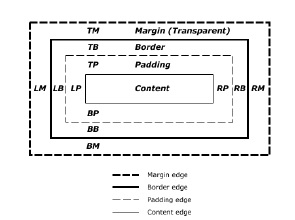CSS中的盒模型是什么?
- WBOYWBOYWBOYWBOYWBOYWBOYWBOYWBOYWBOYWBOYWBOYWBOYWB转载
- 2023-08-23 13:37:05841浏览
每个HTML文档中的元素都由浏览器呈现为一个矩形框。宽度、高度、内边距和外边距确定了元素周围的空间。下图说明了盒模型的概念 −

来源:w3.org
内容
这包括以文本、图像或其他媒体内容形式的实际数据。宽度和高度属性修改此框的尺寸。
内边距
内容的外边缘与其边框之间的空间称为内边距。此框可以通过内边距属性调整大小。边缘特定属性,如padding-left、padding-bottom等,有助于实现自定义间距。
边框
内边距的外边缘与外边距的内边缘之间的距离定义了元素的边框。默认情况下,其宽度设置为0。边框属性用于定义元素的边框。也可以为单个边缘设置样式。
外边距
元素的框与其周围元素的框之间的空间被定义为外边距。这类似于页面边距,页面边距被定义为页面边缘与其内容之间的空间。它的颜色是透明的,模拟了内边距的属性,除了它清除了元素边框外的区域。与内边距类似,可以定义单个边缘具有自定义的外边距。
示例
演示
<!DOCTYPE html>
<html>
<head>
<style>
body * {
outline: solid;
}
#demo {
margin: auto;
width: 50%;
padding: 1em;
border: 1px outset;
display: flex;
box-shadow: inset 0 0 15px mediumvioletred;
box-sizing: border-box;
}
#demo div {
padding: 2em;
box-shadow: inset 0 0 9px orange;
}
</style>
</head>
<body>
<div id="demo">
<div></div>
<div></div>
<div></div>
<div></div>
</div>
</body>
</html>输出
这将产生以下输出 −

示例
演示
<!DOCTYPE html>
<html>
<head>
<style>
body * {
outline: thin dotted;
}
#demo {
margin: auto;
width: 120px;
height: 120px;
padding: 1em;
border: 1px outset;
display: flex;
box-shadow: inset 0 0 15px indianred;
}
#demo div {
width: 40px;
height: 40px;
}
div:nth-child(odd) {
border: inset lightgreen;
border-bottom-right-radius: 100px;
border-bottom-left-radius: 100px;
}
div:nth-child(even) {
border: inset lightblue;
padding: 0.5em;
}
</style>
</head>
<body>
<div id="demo">
<div></div>
<div></div>
<div></div>
</div>
</body>
</html>输出
这将产生以下输出 −

以上是CSS中的盒模型是什么?的详细内容。更多信息请关注PHP中文网其他相关文章!
声明:
本文转载于:tutorialspoint.com。如有侵权,请联系admin@php.cn删除

